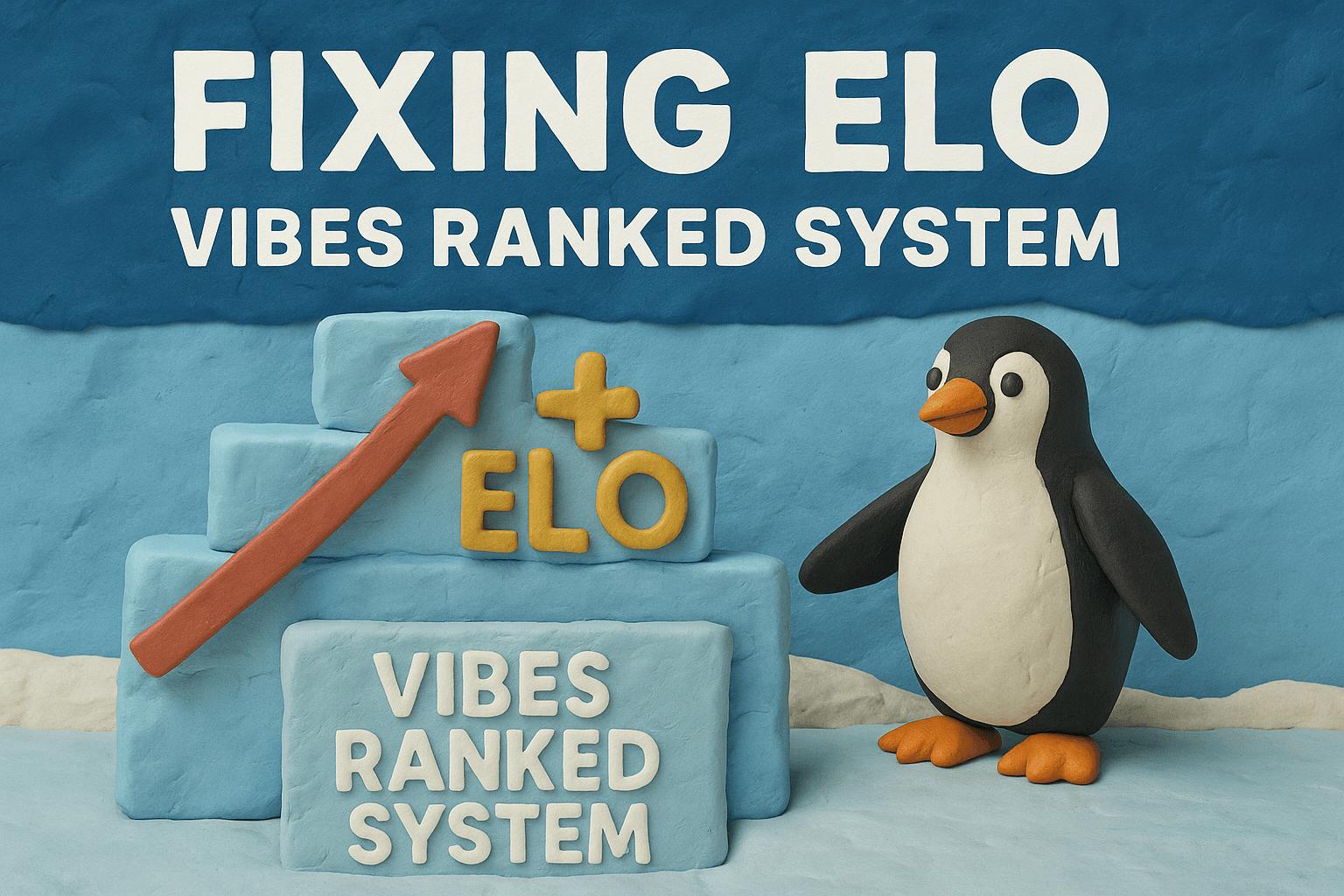Fixing ELO(ish): Evolving the Vibes Ranked System for Season 1

TL;DR: Vibes’ Season 0 ranking system over-rewarded grinders. Season 1’s modified ELO attempted to fix that by focusing on skill, but ended up punishing top players who kept playing. Our latest fix adds a minimum point gain per win, encouraging activity again. We're planning a balanced redesign for Season 2.
Fixing ELO(ish): Evolving the Vibes Ranked System for Season 1
At Vibes, our north star has always been simple: build a ranking system that rewards both playing more and playing better. Season 0 was our first real attempt, and it taught us a lot—both about what works and what doesn’t.
Season 0: The Grinder’s Paradise
In Season 0, rank was determined by a combination of total wins and win rate. On paper, this struck a balance. In practice, it didn’t.
Every one of the top 8 players who qualified for Worlds played over 1,000 games, each with a win rate north of 78%. We had people playing 18 hours a day for weeks. That’s an incredible testament to our community’s passion—but it’s also a clear warning sign. Burnout is real, and we don’t want our most dedicated players to feel like they have to push themselves to unhealthy extremes to compete.
This system heavily favored volume over skill. There wasn’t a realistic path for someone highly skilled—but time-limited—to reach the top. And that’s not the competitive ecosystem we want to foster.
Enter ELO: What We Took and What We Changed
To better reward skill over raw volume, we turned to a system long used in competitive games and sports: ELO.
At its core, ELO works like this:
Beat a stronger player? Gain more points.
Beat a weaker player? Gain fewer.
Lose to a weaker player? Lose a lot.
This makes intuitive sense and works beautifully in a deterministic game like chess, where the better player should win most of the time. But Trading Card Games (TCGs) aren’t chess.
Why TCGs Aren’t Chess
Unlike chess, TCGs involve hidden information, variance, and deck-building metagames. Even the best TCG players rarely top 70% win rates. In Magic: The Gathering, 65% is considered elite. In Flesh & Blood, where matchups skew more deterministic, maybe it's closer to 80%. At Vibes, we estimate our game sits somewhere between Magic and FaB.
So we needed to tweak ELO to work in a world where outcomes aren't perfectly skill-determined.
Our Initial Season 1 Modifications
We introduced two key changes to traditional ELO for the start of Season 1:
Sliding Scale ELO Integration
The higher you are within Dummy Thicc, the impact of ELO increases as you rise.
Early on, win/losses award a flat number of points.
Higher rungs on the latter rely more heavily on ELO calculations.
At the top, it’s almost all ELO.
Rating Decay for Inactivity
Players who don’t play regularly have their rating drop over time.
The goal: encourage continued play and avoid “camping” at the top.
Where It Went Wrong: The “Don’t Play” Meta
On paper, our Season 1 ELO concept looked like a win. But in practice, we saw an unintended side effect.
When several top players stopped playing entirely, active top players saw their ELO drop faster—even while winning. Why? Because they were playing (and beating) lower-ranked opponents, earning minimal points per win and risking huge losses for any slip-up. Meanwhile, inactive players’ slow decay didn’t offset the grind.
In the last month, the average active top-16 player lost ~130 ELO, even with strong win rates. In other words: the optimal strategy was not playing. Oof.
This violated both of our goals. It didn’t reward playing more or playing better.
Our Fix: Minimum Point Gains
With three weeks left in Season 1, we’re rolling out a final fix to rebalance the ladder:
Every win now gives a minimum point gain, no matter your ELO or your opponent’s.
That means active top players will now gain rating over time rather than lose it, even if they’re only matching into lower-tier opponents.
We’re supplementing the existing rating decay with something subtler but more effective: opportunity cost. If you don’t play, you’re not earning those guaranteed points—meaning active players can now pass you more easily.
A Tradeoff: Unlimited ELO?
One curious side effect of this change: there’s now no theoretical cap to the maximum ELO a player can reach. That’s usually not the case in traditional ELO systems.
This could’ve been problematic earlier in the season—newcomers would have had no realistic way to catch up. But with only a few weeks left, that’s a tolerable tradeoff.
Looking Ahead to Season 2
We don’t plan to carry this exact system forward. It skews too far in the other direction—grind-heavy again, just in a different flavor.
Instead, for Season 2, we’re exploring formulas that land somewhere between the grind of Season 0 and the pure skill measurement (with issues) of Season 1. A system that truly rewards:
Consistent, excellent play.
Time investment—without burnout.
Comeback potential for late-season entries.
Engagement from the entire playerbase.
We don’t have all the answers yet—but we’re iterating fast, and transparently. Thanks for bearing with us while we fine-tune the vibe.





